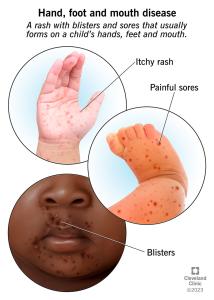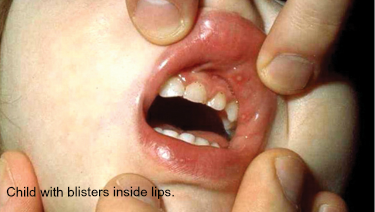Hand, Foot and Mouth Disease

As pediatricians, we know how concerning it can be when your child isn't feeling well. One of the most common illnesses we see, especially in the Summer and Fall, is Hand, Foot and Mouth Disease (HFMD).
While the name might sound a little scary, it's a very common and usually mild viral illness that most children recover from completely within a week to ten days. My goal today is to help you understand what HFMD is, how to care for your child, and when it’s time to call us.
What Exactly is Hand, Foot, and Mouth Disease?
Hand, Foot, and Mouth Disease is caused by a virus, most often the coxsackievirus. It spreads very easily from person to person, which is why it’s so common in places where children gather, like daycares, preschools, and playgrounds.
The most tell-tale signs of HFMD are:
- Fever: Often the first symptom, and it may be accompanied by a sore throat and a general feeling of being unwell.
- Sores in the mouth: Small, painful blisters can develop on the tongue, gums, and inside of the cheeks. These can make eating and drinking very uncomfortable.
- Rash on the hands and feet: A non-itchy rash of red spots, sometimes with small blisters, can appear on the palms of the hands, soles of the feet, and sometimes on the buttocks.


Images from Cleveland Clinic and Healthychildren.org.
How Do We Care for a Child with HFMD?
The good news is that there is no specific medication to treat HFMD. Since it’s a virus, antibiotics won't help. The focus of treatment is to ease your child’s symptoms and keep them comfortable as their body fights off the infection.
- Hydration is Key: This is the most important thing you can do! The mouth sores can be very painful, and children may refuse to drink. Dehydration is the most common reason a child with HFMD ends up in the hospital. Offer small, frequent sips of cool water, diluted juice, or an oral rehydration solution. Frozen treats like popsicles can also be very soothing and encourage fluid intake.
- Pain Relief: Over-the-counter pain relievers like acetaminophen or ibuprofen (if your child is over 6 months old) can help reduce fever and ease mouth pain. Please be sure to follow the dosing instructions carefully.
- Comfort Foods: Soft, bland foods are best. Avoid salty, spicy, or acidic foods that can sting the mouth sores. Think about things like yogurt, applesauce, mashed potatoes, and scrambled eggs.
How Can We Prevent the Spread?
Hand, Foot, and Mouth Disease is highly contagious, but there are simple steps you can take to help protect your family:
- Handwashing, Handwashing, Handwashing! This is the best defense. Teach your children to wash their hands frequently with soap and water for at least 20 seconds, especially after using the bathroom, before eating, and after touching their face.
- Disinfect Surfaces: The virus can live on surfaces for several days. Regularly clean and disinfect high-traffic areas and shared toys, especially in your home, at daycare, or in schools.
- Avoid Close Contact: The virus spreads through saliva, blister fluid, and stool. Encourage your child to avoid sharing cups, utensils, and personal items with others.
When Can My Child Return to Daycare or School?
This is a question I get all the time, and it's a very important one. The general rule is that your child should stay home from school or daycare until:
- Their fever has been gone for at least 24 hours without the use of fever-reducing medicine.
- They are feeling well enough to participate in class activities.
- Open blisters have crusted over and uncontrolled drooling has stopped.
Often, the rash on the hands and feet can linger for a week or more after the fever is gone. As long as your child is fever-free and feeling well, they are usually no longer a significant risk for spreading the illness, even if the rash is still present.
When Should I Call the Doctor?
While HFMD is typically a mild illness, there are times when it’s important to see us. Please call our office if:
- You are concerned your child is becoming dehydrated (look for signs like a dry mouth, crying with few or no tears, or urinating less frequently than usual).
- The fever is high, lasts for more than three days, or your child seems unusually ill or irritable.
- Your child's mouth sores are so painful that they are refusing to drink fluids for an extended period.
- You notice signs of a serious complication, such as a stiff neck, headache, or confusion. (These are very rare but are worth noting.)
Hand, Foot, and Mouth Disease can be a rough few days for your little one, but with good care and attention to their comfort and hydration, they will be back to their energetic selves in no time.
If you ever have any questions or concerns, please don’t hesitate to call our office. We are always here to help!
